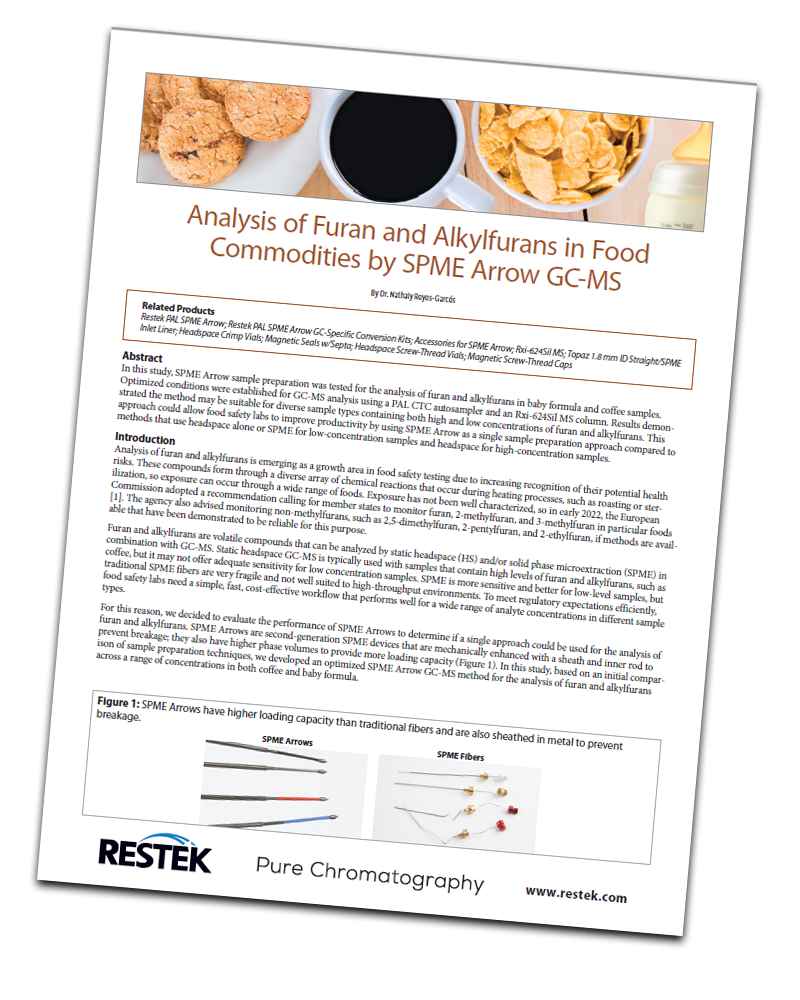Analysis of furan and alkylfurans is emerging as a growth area in food safety testing due to increasing recognition of their potential health risks. In this study, SPME Arrow sample preparation was tested for the analysis of furan and alkylfurans in baby formula and coffee samples.
 Optimized conditions were established for GC-MS analysis using a PAL CTC autosampler and an Rxi-624Sil MS column. Results demonstrated the method may be suitable for diverse sample types containing both high and low concentrations of furan and alkylfurans. This approach could allow food safety labs to improve productivity by using SPME Arrow as a single sample preparation approach compared to methods that use headspace alone or SPME for low-concentration samples and headspace for high-concentration samples.
Optimized conditions were established for GC-MS analysis using a PAL CTC autosampler and an Rxi-624Sil MS column. Results demonstrated the method may be suitable for diverse sample types containing both high and low concentrations of furan and alkylfurans. This approach could allow food safety labs to improve productivity by using SPME Arrow as a single sample preparation approach compared to methods that use headspace alone or SPME for low-concentration samples and headspace for high-concentration samples.
Furans and alkylfurans form through a diverse array of chemical reactions that occur during heating processes, such as roasting or sterilization, so exposure can occur through a wide range of foods. Exposure has not been well characterized, so in early 2022, the European Commission adopted a recommendation calling for member states to monitor furan, 2-methylfuran, and 3-methylfuran in particular foods. The agency also advised monitoring non-methylfurans, such as 2,5-dimethylfuran, 2-pentylfuran, and 2-ethylfuran, if methods are available that have been demonstrated to be reliable for this purpose.
Furan and alkylfurans are volatile compounds that can be analyzed by static headspace (HS) and/or solid phase microextraction (SPME) in combination with GC-MS. Static headspace GC-MS is typically used with samples that contain high levels of furan and alkylfurans, such as coffee, but it may not offer adequate sensitivity for low concentration samples. SPME is more sensitive and better for low-level samples, but
traditional SPME fibers are very fragile and not well suited to high-throughput environments. To meet regulatory expectations efficiently, food safety labs need a simple, fast, cost-effective workflow that performs well for a wide range of analyte concentrations in different sample types.
For this reason, the performance of SPME Arrows was evaluated to determine if a single approach could be used for the analysis of furan and alkylfurans. SPME Arrows are second-generation SPME devices that are mechanically enhanced with a sheath and inner rod to prevent breakage; they also have higher phase volumes to provide more loading capacity. In this study, based on an initial comparison of sample preparation techniques, an optimized SPME Arrow GC-MS method was developed for the analysis of furan and alkylfurans across a range of concentrations in both coffee and baby formula.
The application note concludes that analysis of furan and alkylfurans is complicated by a diverse array of sample types that can contain the target compounds at a wide range of concentrations. Headspace and traditional SPME fibers can be used for high and low concentration samples respectively, but this study sought to establish a single approach that could be adapted for all analyte levels.
If you have a colleague who may be interested in the subject of this application note, please click below.





